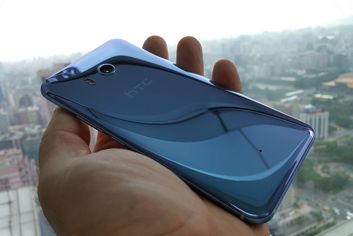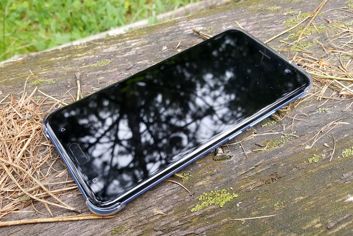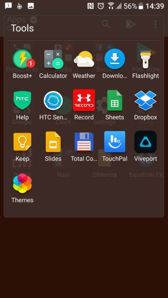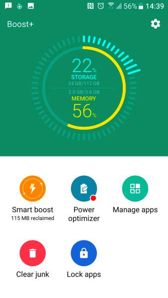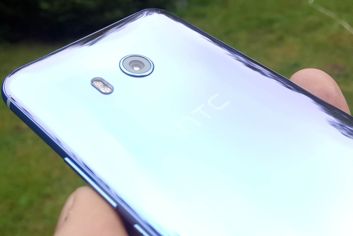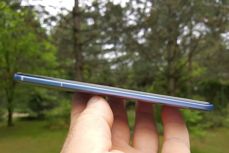Display, interface
photo: Adam Łukowski/GSMchoice.com
Let us look at the display. Basically there is nothing to complain about – we have a 5.5-inch 1440 x 2560 pixels resolution matrix with a traditional 16:9 display ratio. The display is clear, it has a high brightness and it reflects colours well. In addition, there is the possibility to change the colour balance and switch the display to the night time mode – even automatically.
photo: Adam Łukowski/GSMchoice.com
The touch panel works without any problems and in sunny days the display does not create too many reflexes. Unfortunately, HTC does not work in vacuum and in comparison with its competition the display of U11 does not have anything that would have given it an edge. There are no narrow bezels, there are no extraordinary colours or brightness – we just receive a solid but a rather “common” display at the same time.
photo: Adam Łukowski/GSMchoice.com
However, HTC U11 has something that cannot be found in any other phone. We can squeeze it. HTC have developed an interesting solution called Edge Sense for controlling selected functions of the phone using the natural reflex of squeezing the housing. There are ultrasound sensors, which – after a configuration – will interpret the user’s gesture and will trigger a selected action.
photo: Adam Łukowski/GSMchoice.com
We can select between a short and a long squeeze. Each of those gestures can be ascribed with selected action, for example running an appropriate app or function. We can select an app from the list or use default propositions, for example running the camera or a torch, recorder or a hot-spot…
photo: Adam Łukowski/GSMchoice.com
By default, while using this function we can turn on the camera and trigger the shutter, which is probably the best way to use Edge Sense. I have no complaints towards its work, but while choosing HTC U11 and deciding to use the squeezing gesture it is worth remembering to buy an appropriate cover – adjusted to the construction, with uncovered lower parts of housing’s edges.
photo: Adam Łukowski/GSMchoice.com
The function works flawlessly – but is it enough to distinguish HTC U11 among its competition? I admit – it is unique – but I did not have a necessity to use it every day. It is nice that it is there, but if it were not – in my opinion – it would not have change the user’s view about this device. Maybe I am wrong, but I was not astonished by this.
photo: Adam Łukowski/GSMchoice.com
While searching for advantages and distinctive features of HTC U11 it is worth mentioning about the Sense interface. I remember this add-on from previous HTC models. I have always liked it and I considered it as one of the most interesting ones and fortunately, in its next version nothing changes. Some elements require getting used to, but I still consider Sense as a perfected and a practical interface.
photo: Adam Łukowski/GSMchoice.com
The lock screen is rather practical – it has shortcuts for the most important applications, it can display notifications, there is a clock as well – even a double one, when the phone is in roaming. We can wake the smartphone up with a button, by swiping our finger through the display and with a double tap.
photo: Adam Łukowski/GSMchoice.com
We can use the fingerprint scanner as well. It is simple in configuration and – despite a small size – comfortable in usage. It works fast and without any errors, but the manufacturer did not enhance its functionality, for example by using it as a touchpad for browsing lists. It is a pity.
photo: Adam Łukowski/GSMchoice.com
The interface has a traditional form – with desktops and a separate tray app. The only peculiar thing is that we move through desktops horizontally, from left to right, while the tray is browsed vertically. We can get used to it. The arrangement of icons in the tray can be edited manually (by creating folders as well) or we can rely on automatics and sorting it using the alphabet or by the intensity of using.
photo: Adam Łukowski/GSMchoice.com
Using desktops is a standard one, and while swiping the main desktop right we will move to BlinkFeed. This is not – as it has been previously – a simple news aggregate, now we can add to BlinkFeed notifications from some apps or social media.
photo: Adam Łukowski/GSMchoice.com
HTC Sense gives wide personalization capabilities. We can use premade themes or we can modify selected elements of the interface by ourselves, for example the colour of the dialler, text keyboard or selected sounds. There is the possibility to change the size of the font or changing wallpapers, there is gloves mode usage as well. We can use additional gestures, for example running the camera by double swiping our finger through the display.
photo: Adam Łukowski/GSMchoice.com
In HTC U11 there is the possibility to work on a divided screen. We can run it by holding the “last used apps” button a bit longer, and then we can change the size of windows. Unfortunately, not all apps support this solution – but it is normal. The notifications section is a standard one, just like the notifications panel. We can of course change their arrangement.
photo: Adam Łukowski/GSMchoice.com
The HTC Boost+ is the cherry on the top, it cleans RAM from apps, removes garbage files and manages the power usage. We can choose which app will work in the background and which are supposed to finish their job right after closing them.
photo: Adam Łukowski/GSMchoice.com
In the Sense interface there is Sense Companion assistant, which has the possibility to “learn” our habits based on how we are using the phone, in order to display different notifications, depending on the context and the situation.
photo: Adam Łukowski/GSMchoice.com
The function is not invasive and it does not irritate the user with an abundance of distractions. It is worth mentioning that U11 can simultaneously (and interchangeably) work with Google and Amazon voice assistants.
photo: Adam Łukowski/GSMchoice.com
Basically I view the interface positively. I like most used solutions, the smooth and able work and the lack of typical bloatware apps. Those that are “additionally” installed by HTC, for example Vive Port or UnderArmour Record – can be easily uninstalled.
Source: GSMchoice.com



